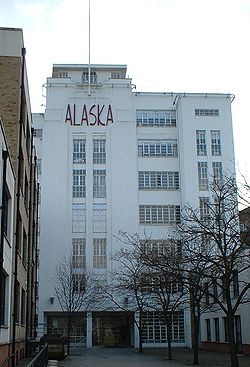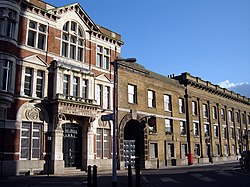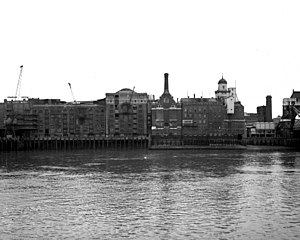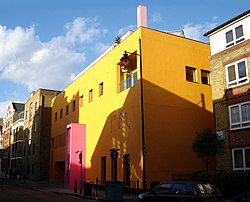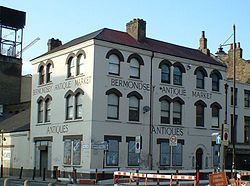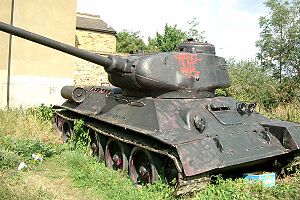Bermondsey
| Bermondsey | |
| Surrey | |
|---|---|
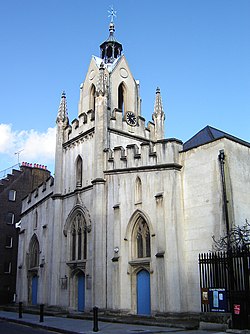 St Mary Magdalen Church, Bermondsey | |
| Location | |
| Grid reference: | TQ335795 |
| Location: | 51°29’55"N, 0°4’33"W |
| Data | |
| Post town: | London |
| Postcode: | SE1, SE16 |
| Dialling code: | 020 |
| Local Government | |
| Council: | Southwark |
| Parliamentary constituency: |
North Southwark and Bermondsey |
Bermondsey is a town in the very north-east of Surrey standing on the south bank of the river Thames at the end of Tower Bridge. It is deep within the metropolitan conurbation, having been swallowed up in London's growing urban spread from its earliest times, and is completely contiguous with the towns around it. Immediately to the west of Bermondsey lies Southwark and to the east is Rotherhithe. To the south are Walworth and Peckham.
History
Toponomy
Bermondsey may be understood to mean Beornmund's island; but, while Beornmund represents an Old English personal name, identifying an individual once associated with the place, the element "-ey" represents Old English eg, for "island", "piece of firm land in a fen", or simply a "place by a stream or river". Thus Bermondsey need not have been an island as such in the Anglo-Saxon period, and is as likely to have been a higher, drier spot in an otherwise marshy area.[1] Though Bermondsey's earliest written appearance is in the Domesday Book of 1086, it also appears in a source which, though surviving only in a copy written at Peterborough Abbey in the 12th century, claiming "ancient rights" unproven purporting to be a transcription of a letter of Pope Constantine (708–715), in which he grants privileges to a monastery at Vermundesei, then in the hands of the abbot of Medeshamstede, as Peterborough was known at the time.[2]
Anglo-Saxon and Norman period
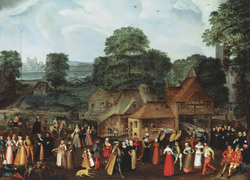
Bermondsey appears in the Domesday Book as Bermundesy and Bermundesye, in the Hundred of Brixton within the County of Surrey.[3] It was then held by King William, though a small part was in the hands of Robert, Count of Mortain, the king's half brother, and younger brother of Odo of Bayeux, then earl of Kent. Its Domesday assets were recorded as including 13 hides, 'a new and handsome church', 5 ploughs, 20 acres of meadow, and woodland for 5 pigs. It rendered £15 in total. It also included interests in London, in respect of which 13 burgesses paid 44d.[4]
The church mentioned in Domesday Book was presumably the nascent Bermondsey Abbey, which was founded as a Cluniac priory in 1082, and was dedicated to St Saviour. Monks from the abbey began the development of the area, cultivating the land and embanking the riverside. They turned an adjacent tidal inlet at the mouth of the River Neckinger into a dock, named St Saviour's Dock after their abbey. But Bermondsey then was little more than a high street ribbon (the modern Bermondsey Street), leading from the southern bank of the Thames, at Tooley Street, up to the abbey close.
The Knights Templar also owned land here and gave their names to one of the most distinctive streets in London, Shad Thames (a corruption of "St John at Thames"). Other ecclesiastical properties stood nearby at Tooley (a corruption of "St Olave's") Street, located in the Archbishop of Canterbury's manor of Southwark, where wealthy citizens and clerics had their houses, including the priors of Lewes and St Augustine's, Canterbury, and the abbot of Battle.
14th century
King Edward III built a manor house close to the Thames in Bermondsey in 1353. The excavated foundations are visible next to Bermondsey Wall East close to the famous Angel public house.[5]
17th century
As it developed over the centuries, Bermondsey underwent some striking changes. After the Great Fire of London, it was settled by the well-to-do and took on the character of a garden suburb especially along the lines of Grange Road, as Bermondsey Street became more urbanised, and of Jamaica/ Lower Road. A pleasure garden was founded there in the 17th century, commemorated by the Cherry Garden Pier. Samuel Pepys visited "Jamaica House" at Cherry Gardens in 1664 and recorded in his diary that he had left it "singing finely". Jamaica Road still remains.
Though not many buildings survive from this era, one notable exception is the church of St Mary Magdalen in Bermondsey Street, completed in 1690 (although a church has been recorded on this site from the 13th Century). This church came through both 19th-century redevelopment and The Blitz unscathed. It is not just an unusual survivor for Bermondsey; buildings of this era are relative rarities in Inner London in general.
18th century
In the 18th century, the discovery of a spring from the river Neckinger in the area led to the development of Bermondsey Spa, as the area between Grange and Jamaica Roads called Spa Road commemorates.[6] A new church was built for the growing population of the area, and named St John Horsleydown.
19th century
It was from the Bermondsey riverside that the painter J.M.W. Turner executed his famous painting of The Fighting "Temeraire" Tugged to her Last Berth to be Broken Up (1839), depicting the veteran warship being towed to Rotherhithe to be scrapped.
By the mid-19th century, parts of Bermondsey, especially along the riverside, had become notorious slums with the arrival of industrial plants, docks and immigrant housing. The area around St Saviour's Dock, known as Jacob's Island, was one of the worst in London. It was immortalised in Charles Dickens's novel Oliver Twist, in which the villain, Bill Sikes, meets his end in the mud of 'Folly Ditch', in reference to Hickman's Folly, which surrounded Jacob's Island.[7][8] Dickens provides a vivid description of what it was like:[9]
... crazy wooden galleries common to the backs of half a dozen houses, with holes from which to look upon the slime beneath; windows, broken and patched, with poles thrust out, on which to dry the linen that is never there; rooms so small, so filthy, so confined, that the air would seem to be too tainted even for the dirt and squalor which they shelter; wooden chambers thrusting themselves out above the mud and threatening to fall into it—as some have done; dirt-besmeared walls and decaying foundations, every repulsive lineament of poverty, every loathsome indication of filth, rot, and garbage: all these ornament the banks of Jacob's Island.
Bermondsey Town Hall was built on Spa Road in 1881 but Blitzed in 1941. The area was extensively redeveloped during the 19th century and early 20th century with the expansion of the river trade and the arrival of the railways. London's first passenger railway terminus was built by the London to Greenwich Railway in 1836 at London Bridge. The first section to be used was between the Spa Road Station and Deptford High Street. This local station had closed by 1915.
The industrial boom of the 19th century was an extension of Bermondsey's manufacturing role in earlier eras. As in the East End, industries that were deemed too noisome to be carried on within the narrow confines of the City of London had been located here — one such that came to dominate central Bermondsey, away from the riverfront, was the processing and trading of leather and hides. Many of the warehouse buildings from this era survive around Bermondsey Street, Tanner Street, Morocco Street and Leathermarket Street including the huge Leather Market of 1833 and the Leather, Hide and Wool Exchange of 1878; virtually all are now residential and small work spaces or offices). Hepburn and Gale's tannery (disused as of early 2007) on Long Lane is also a substantial surviving building of the leather trade. The Exchange building had a fine private club, effectively a gentlemen's club for the leading merchants and manufacturers. In 1703 they had acquired a royal charter from Queen Anne to gain a monopoly of trading and training of apprentices for within 30 miles of the ancient parish, similar to a City livery company, the Bermondsey Tanners.
Peek, Frean and Co was established in 1857 at Dockhead, Bermondsey by James Peek and George Hender Frean. They moved to a larger plant in Clements Road in 1866, leading to the nickname 'Biscuit Town' for Bermondsey, where they continued baking until the brand was discontinued in 1989.[10][11][12]
Bermondsey, specifically Blue Anchor Lane, was also the location of the world's first food canning business, established in 1812, by Donkin, Hall and Gamble.[13][14]
20th century
To the east of Tower Bridge, Bermondsey's 3.0 mile (3.8 km) of riverside were lined with warehouses and wharves, of which the best known is Butler's Wharf. They suffered severe damage in World War II bombing and became redundant in the 1960s following the collapse of the river trade. After standing derelict for some years, many of the wharves were redeveloped under the aegis of the London Docklands Development Corporation during the 1980s. They have now been converted into a mixture of residential and commercial accommodations and have become some of the most upmarket and expensive properties in London. In 1997, US President Bill Clinton and Prime Minister Tony Blair visited the area to dine at the Le Pont de la Tour restaurant at Butler's Wharf.
Bermondsey had been host to London's first railway, from Spa Road railway station, as part of the London Bridge to Greenwich line, and the junction of lines from Croydon and Kent at South Bermondsey, the Brunels Rotherhithe foot-tunnel was converted into part of the East London Railway with original connections from Liverpool Street Station via Whitechapel to New Cross and New Cross Gate. However, reorganisation of lines and temporary closure of stations left Bermondsey's transport links with the rest of London poorer in the late Twentieth Century. This was remedied in 2000 with the opening of Bermondsey Underground station on the London Underground's Jubilee Line Extension and the East London Line forms part of the new London Overground system reopening direct links with the City and north London.
The Blue serves as the central market place for Bermondsey as a whole.
Wee Willie Harris, known as "Britain's wild man of rock 'n' roll", came from Bermondsey[15] and had worked as a pudding mixer at Peek Freans.[16] He is usually credited as the first British rock and roll player.[17]
Borough
The first 'Bermondsey' is that known as the location of an Anglo-Saxon monastery, and known from later charters to be the area around the post-Conquest Bermondsey Abbey and its manor, which was in turn part of the medieval parish. References in the Parliamentary Rolls describe it as "in Southwark".[[18]] A later, Victorian civil parish of Bermondsey did not include Rotherhithe or St Olave's. The Southwark parishes of St Olave's and St John's Horsleydown (the latter a 'daughter' of the former) with St Thomas's formed a parish union ('District Board of Works') known as 'St Olave's' from that date. In 1899 St Olave and St Thomas's District was created as a single civil parish and the next year this was merged with Rotherhithe and part of Deptford to form, with Bermondsey civil parish, the borough of Bermondsey. The Borough's first Mayor was Samuel Bourne Bevington (1832–1907), leather producer and one of the area's largest employers; his statue still stands in Tooley Street.[19]
Sport
Millwall Football Club was originally formed in 1885, in Millwall on the Isle of Dogs in Middlesex. They retained the name, even though they moved across the river to New Cross, Surrey in 1910. In 1993 they moved to their current stadium, The Den. The team has a strong local following, but has never been based in Bermondsey. The nearest railway station is at SSouth Bermondsey, which is a five-minute walk away.
Geography
Places of interest
- Maltby Street Market
- Bermondsey antiques market
- Fashion and Textile Museum
- Shad Thames
- Mandela Way T-34 Tank
- Miloco Studios
- Bermondsey Spa Gardens
- Kagyu Samye Dzong, Tibetan Buddhist Centre
- Millwall F.C.
- HMS Belfast
- Tower Bridge
Transport
Rail
There are several railway stations in and around Bermondsey. Bermondsey is in London Zone 2, but nearby London Bridge and Borough stations are in travelcard Zone 1. Oyster Cards can be used for travel from stations in Bermondsey to other stations in the London region.
London Underground
The Jubilee line passes through Bermondsey, calling at Bermondsey and Canada Water stations. London Bridge station on the Jubilee and Northern lines, and Borough on the Northern line are also nearby.
The Jubilee line provides a direct link from Bermondsey to Canary Wharf and Stratford in London's East End, and to Waterloo, the West End, Baker Street and north-west London towards Willesden and Stanmore. The Northern line from London Bridge links the area to Kennington, Clapham and Morden in the south. Northbound services travel through the City of London, King's Cross St Pancras and Camden Town, towards Edgware or High Barnet.[20]
National Rail & London Overground
The East London Line, South London Line and South Eastern Main Line all pass through Bermondsey, providing frequent rail connections to central London and the south-east.[20]
London Bridge is the busiest station in the locale, and fourth busiest station in the UK, with 48.5 million passenger entries and exits in 2017-18.[21] Services from London Bridge are provided by Southeastern, Thameslink and Southern. London Bridge connects Bermondsey directly to destinations in Central London, including Waterloo, Charing Cross, Cannon Street, Farringdon and St Pancras International. Beyond London, trains travel direct to Gatwick and Luton airports, and destinations including Bedford, Brighton, Cambridge, Dover, Peterborough and Sevenoaks.
South Bermondsey is served by Southern trains from London Bridge to south London, with direct connections to Beckenham Junction, Crystal Palace and Croydon.
Rotherhithe, Canada Water and Surrey Quays are all served by London Overground trains. These stations link Bermondsey with Shoreditch, Dalston and Highbury & Islington to the north. To the south, Bermondsey is linked directly to New Cross, Penge, West Croydon, Crystal Palace, Denmark Hill and Clapham Junction.
Peckham Rye station, just south of Bermondsey, is also an interchange served by Southeastern, Thameslink and Southern, with direct trains to London Victoria station.[20]
Road
Several of London's arterial routes pass through Bermondsey, including:
- the A100 (Tower Bridge Road) - the London Inner Ring Road towards the City and Tower Bridge;
- the A101 (Rotherhithe Tunnel) - to Limehouse, Canary Wharf, the A13 and destinations in Essex;
- the A2 (Great Dover Street/Old Kent Road) - to the M25, destinations in Kent and the Channel Tunnel;
- the A200 (Jamaica Road/Lower Road) - to London Bridge and Deptford;
- the A202 (New Kent Road) - the London Inner Ring Road towards Elephant & Castle and the A3;
- the A2206 (Southwark Park Road);
- the A2208 (Rotherhithe New Road).
Bricklayer's Arms is a busy road junction between the London Inner Ring Road (A100/A202) and the A2, where routes from London Bridge meet with routes towards the East End, Surrey and Kent.
The southern portal of the Rotherhithe Tunnel (A101) is in Bermondsey. The Tunnel was completed in 1908 and carries vehicle traffic from Bermondsey directly to the East End. In 2003, the Tunnel was rated the tenth most dangerous tunnel in Europe, owing in parts to its age and lack of safety features.[22]
References
- ↑ Ekwall, E., The Concise Oxford Dictionary of English Place-Names, 4th edn., Oxford University Press, 1960, pp. 39, 161 (for "eg").
- ↑ See e.g. Stenton, F.M., 'Medeshamstede and its Colonies', in Stenton, D.M. (ed.), Preparatory to Anglo-Saxon England Being the Collected Papers of Frank Merry Stenton, Oxford University Press, 1970, and Blair, J., 'Frithuwold's kingdom and the origins of Surrey', in Bassett, S. (ed.), The Origins of Anglo-Saxon Kingdoms, Leicester University Press, 1989.
- ↑ Open Domesday Online: Bermondsey, accessed January 2020.
- ↑ Williams, A. & Martin, G.H. (eds.), Domesday Book A Complete Translation, Penguin, 2002, pp. 72, 80.
- ↑ Staff. The London Borough of Southwark English Heritage. (cached) "This page provides an overview of the Borough’s fascinating archaeology..."
- ↑ Bermondsey Spa Gardens, Sean Spurr, Bermondsey.org, Accessed 5 August 2012
- ↑ Dance, Caecilia (2013-11-10). "Filth, disease and Dickens: Jacob’s Island, a London slum" (in en-GB). Dance's Historical Miscellany. http://www.danceshistoricalmiscellany.com/filth-disease-dickens-jacobs-island-london-slum/. Retrieved 2018-08-04.
- ↑ Somerville, Howard. "Jacob's Island". http://www.hsomerville.com/meccano/Articles/JacobsIsland.htm. Retrieved 2018-08-04.
- ↑ Dickens, Charles (1996). "Chapter 50: The Pursuit and Escape". Oliver Twist; or, the Parish Boy's Progress. https://www.gutenberg.org/files/730/730-h/730-h.htm.
- ↑ "Peek Frean's Biscuit Factory – The location of the old sweet smelling biscuit factory!". The Shady Old Lady. http://www.shadyoldlady.com/location.php?loc=764. Retrieved 27 February 2012.Peek Frean's Biscuit Factory in Bermondsey, London
- ↑ Hibbert, Colette (8 February 2005). "Biscuit factory makes 'comeback'". BBC News. BBC. http://news.bbc.co.uk/2/hi/uk_news/4213787.stm. Retrieved 27 February 2012.Biscuit Factory Makes 'Comeback', BBC News, 8 Feb 2005
- ↑ "Bermondsey blue plaques". Blue Plaques. Southwark Council. http://www.southwark.gov.uk/info/200160/blue_plaques/2201/bermondsey_blue_plaques/1. Retrieved 27 February 2012.
- ↑ Greenland, Maureen; Day, Russ (2016). Bryan Donkin: The Very Civil Engineer, 1768–1855. England: Phillimore Book Publishing. ISBN 978-0-9934680-1-8.
- ↑ Robertson, Gordon L. (2005). Food Packaging: Principles and Practice. CRC Press. pp. 123. ISBN 0-8493-3775-5.
- ↑ Wee Willie Harris, Rockin' At The Two I's
- ↑ Tobler, John (1992). NME Rock 'N' Roll Years (1st ed.). London: Reed International Books Ltd. p. 49. CN 5585.
- ↑ R. Unterberger, [[[:Template:Allmusic]] "British Rock & Roll Before the Beatles"], Allmusic retrieved 24 July 1209.
- ↑ en Bermondeshey en Southwark entry 1381- 82 referring to location of a tenement in Rotuli Parliamentorum III, 130: and in John Stow's Survey of London II, 142, 66–68 he describes St Mary Magdalen Church, Bermondsey as lying in the borough of Southwarke
- ↑ Farrell, Jerome: Big in Bermondsey: Colonel Sam Bevington, in the Leathersellers' Review, 2009–10, pp 16–17
- ↑ 20.0 20.1 20.2 "London's Rail & Tube Services". http://content.tfl.gov.uk/london-rail-and-tube-services-map.pdf.
- ↑ "Top 10 stations in Great Britain". https://orr.gov.uk/__data/assets/image/0009/39951/station-usage-2017-18-top-10-gb-stations.png.
- ↑ "UK's 'dangerous' road tunnels" (in en-GB). 2003-04-24. http://news.bbc.co.uk/2/hi/uk_news/2970901.stm. Retrieved 2019-04-08.
Outside links
| ("Wikimedia Commons" has material about Bermondsey) |
